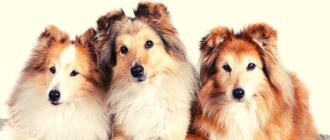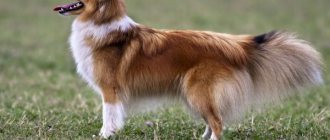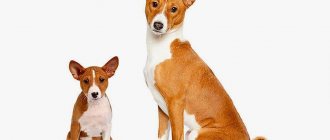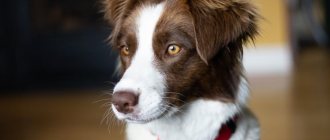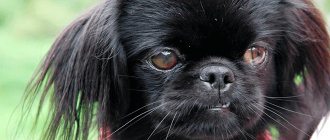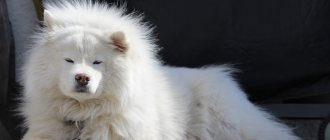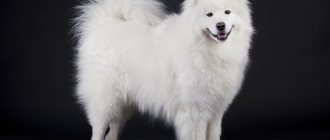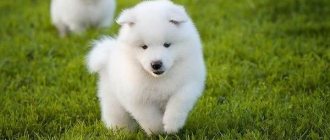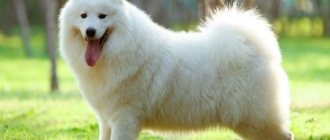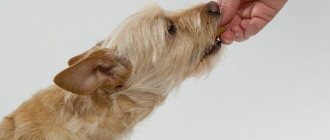Cute fluffy dogs - Samoyeds - are the real pride of Russia. These are the oldest pets of the North of Russia and Siberia.
Samoyed snow-white huskies have a playful, gentle disposition. They are perfect for both a large family and one person. Samoyeds can be entrusted with children who will be supervised. If the animal senses danger, they will signal by barking, which indicates the exceptional qualities of the guard.
Description of the Samoyed Laika breed
Popularity 118th place among 263 dog breeds
Lifespan:
12-15 years
Breed group:
Service
Height:
50-55 cm
Country of origin:
Siberia and northern Russia
Average price:
20-30 thousand rubles
Weight:
15-30 kg
Latest articles Cat health
Rabies vaccination for cats: choice of vaccine, necessity, schedule 01/22/2022 4 0 0
Selection and adaptation
TOP 20 best cat breeds for families with children 01/22/2022 25 0 0
Advantages and disadvantages
- Pros:
- good-natured and sociable, including with children;
- gets along well in an apartment;
- has good health, is strong and resilient;
- does not require special care and nutrition.
- Minuses:
- has a hard time with loneliness or resentment, as a result of which things in the apartment suffer;
- sheds heavily and requires combing;
- tries to take the place of leader, which complicates training;
- is quite expensive.
Key facts
You have no chance of being ignored when you go for a walk with this dog: the large snow-white dog invariably attracts attention and causes admiration.
The Samoyed is a primitive or indigenous breed, meaning that no selective breeding methods were used to breed it. This becomes clear upon a quick reading of the main characteristics of the Samoyed breed.
Samoyed huskies live in a pack according to its laws. The Samoyed is a friendly, quick-witted animal, but not prone to obedience the first time. This is where the nature of the breed comes into play.
Don't put the Samoyed on a chain! Although this breed can handle cold winter nights well, it is a companion dog, not a guard dog, and therefore does not like to be alone. The description of the Samoyed breed emphasizes that a dog will not make a watchman.
Samoyeds have the character of a loyal companion, focused on living in human society. For many centuries they have served people in the extreme north and extreme cold. A dog living with a person in such conditions has a special character. In the Arctic, they are indispensable helpers for people - they hunt large animals with them, nurse children, and protect herds of deer.
But they were not particularly used in dog sleds, since the cultural traditions of the Nenets do not allow the use of these dogs as sled dogs. There are several photos of northerners with dog sleds, but they are harnessed to other dogs. At night, Samoyeds are often allowed into the tent and cuddle with them while they sleep.
Thanks to the purity of genes, the life expectancy of Samoyeds is very long. Under appropriate conditions, snow-white beauties live 14-15 years or more.
The Samoyed Laika is an unusual breed; none of its names reflect all of its characteristics. You can immediately recognize her by her fur, easy smile, curiosity and love for people. This dog delights those around him and his owners.
Breed Features
The main distinguishing feature of the Samoyed Laika is its stunning snow-white fur . It attracts attention everywhere and makes the dog look like a fluffy polar bear. Since the breed belongs to the northern species, thick coat is a necessity to adapt to severe frosts, and the white color camouflages the dog in the snow. Contrary to popular belief, Samoyeds can tolerate hot summers well, but it is better not to leave the dog for a long time in a stuffy room or in the scorching rays of the sun.
As for character, Samoyed huskies are friendly, sociable and loyal. They constantly need human communication and willingly make contact with children and other animals. The corners of the Samoyed's lips are slightly raised, making it seem as if they are constantly smiling.
These dogs need constant physical activity as they are a sled breed. Samoyed owners need to provide their pets with long walks in the fresh air, active games and friendly communication.
History of the origin of the Samoyed dog
For about three thousand years, Samoyed dogs have been faithful companions of people. Their appearance has remained virtually unchanged since ancient times.
The first mentions of them can be found in the Samoyed language. Some of the Samoyeds - the ancestors of the Nenets - separated from the main people and moved from the Sayan Mountains in modern Khakassia to the Arctic Circle.
The Samoyed people also bore other names - “Samoyeds”, “Samoyeds”, “Samoyeds”. Their dogs got their name from the name of the nationality. The sammie is believed to be a domesticated polar white wolf. Northern working dogs are especially similar to their ancestor.
The ancestor of modern dogs is the Aboriginal Samoyed. We owe the existence of the breed in its current form to Londoner Ernst Kilburn Scott, who brought three dogs from a trip to the Arctic - a coffee baby with the simple name Dog, a cream-colored female White Pechora and a snowy male Masti. The modern Western Samoyed dates back to these and other dogs brought by researchers a little later.
In 1909, Scott created the Farmingham kennel, and a little later a club for admirers of northern dogs arose. Around the same time, the breed standard was determined, which has remained virtually unchanged since then.
E. C. Scott informally classified all Samoyeds into three types: wolf-shaped, bear-shaped and fox-shaped. This division continues today. Their difference lies in the structure of the head.
The standard has remained virtually unchanged since its inception, last modified in 1988 by the British Kennel Club.
For 20 years, the breed won the hearts of people, and by the 30s, nurseries appeared in different parts of Europe. Thanks to them, we know the Samoyed Laika, since in our time it is almost impossible to find an aboriginal Samoyed even in the Far North, although Nenets Laikas live there, among which there are many white dogs that look like the aborigines. The number of Samoyeds in the Russian Federation today is about 2,500 individuals.
A little history
Samoyeds, or Samoyeds (indigenous small peoples of Russia) lived about 3 thousand years ago. The nomadic nature of this population implied the presence of hardy mounts in snowy terrain. From them came a beautiful dog - the Samoyed Laika, intended for hunting and protection. Samoyeds helped herd livestock, guarded deer, took part in hunting, and even nursed and warmed children. These dogs are not afraid of severe frost.
The magnificent white coat at that time served to warm its owners. For the night, dogs were taken into the house and used as heating pads. Today this breed is quite rare, which is why the cost of Samoyeds is high.
Appearance of a Samoyed dog
General impression
The photo of the Samoyed shows that the dog is medium in size, harmonious in build, full of dignity. It is impossible not to notice it and not pay attention to it.
Head
The head is wedge-shaped, powerfully developed with a slightly convex forehead. The ears are set at a sufficient distance. The muzzle gradually tapers away from the skull and ends in a black nose. The rim of the nose always has black pigmentation, and the nose itself can become lighter in winter (the so-called “snow nose”).
The lips also have black pigmentation, and are turned up at the corners in a “Samoyed smile.” The dental formula is complete, the teeth are closed in a scissor bite. The eyes are almond-shaped, with an oriental slant and black edging, set at a wide distance. The ears are triangular in shape, slightly rounded at the ends, mobile, set wide apart; they shouldn't hang.
Neck
The neck is strong and proudly arched.
Torso
The body is almost square, slightly elongated in length. It begins with a powerful chest, continues with a strong back with a pronounced waist, and ends with a slightly sloping croup.
Forelegs
The forelimbs are straight and even, widely spaced, parallel when viewed from the front. The paw is slightly elongated, with elongated toes, between which hair grows to protect against the cold.
Hind limbs
The hind limbs are also straight and parallel, with clear articulation angles and a developed muscle corset.
Tail
The tail is set high, very fluffy and long. When running and when excited, the tail is carried over the back or to the side, but not curled into a donut. When at rest, it hangs relaxed, reaching to the hock joints.
Movements
All the power and tirelessness of the Samoyed is visible in movement. The hind legs push strongly, the front legs move with a powerful swing. The step itself is long.
Wool
The coat is fluffy, the coat is “double”: the top layer is made of long and hard guard hair, and the bottom “lining” is made of short, soft undercoat, similar to fluff. A particularly thick “collar” is formed around the shoulders and neck. In males it is more pronounced than in females. On the head and front legs the hair is shorter, on the ears it grows perpendicular to the surface of the ear, and there is also hair inside the ear.
Hind legs with good feathering, forming fluffy pants. Males have coarser hair than females. The Samoyed's fur sparkles and has miraculous abilities - it fluffs up in the cold, and the stronger the frost, the fluffier the dog. In addition, she knows how to clean herself. Wool is hypoallergenic and has no characteristic odor.
Color
Samoyed colors come in several variations: snow white, cream or basic white with a few biscuit spots. In no case should the color or markings appear beige or light brown.
Dimensions
Samoyeds vary in height by gender. Males are taller than females, their height is 54-60 cm, females - 50-54 cm. The weight of a Samoyed, depending on height and gender, ranges from 20 to 30 kg.
The size of the Samoyed allows it to be kept in an apartment - but only on condition of daily long walks with increased activity.
Appearance of the Samoyed Laika: standard
This breed is distinguished by beautiful white coats. Divided into 2 types:
- Bearish. This is a powerful, muscular dog.
- Wolf. Appearance is dry and elongated.
A muzzle that always has a smile on it, white fur and attractive eyes - this is the first impression of the Samoyed husky. This breed has excellent endurance, power and strength; it is not without reason that they are often used as working dogs.
The standard has the following characteristics:
- the head is powerful with an elongated, slightly convex skull;
- strong jaw with a good scissor bite;
- muscular neck;
- black lobe with well-opened nostrils; in winter, the pigmentation of the nose changes;
- on the muzzle the lines smoothly pass from the forehead to the lobe;
- lips are closed, covering teeth; black pigmentation forms a smile;
- dark, widely spaced, oval eyes, slightly squinting;
- erect triangular ears, round tips;
- elongated body relative to the height at the withers;
- straight, proportional paws;
- the tail is thrown over the back or to the side, hanging down at rest;
- light, jerky movements;
- thick coat with a healthy shine; double undercoat;
- mostly white, sometimes milky;
- By nature, the Samoyed is friendly, active, open, and strong.
In addition, the Samoyed dog is balanced and non-aggressive, socially adapted, and popular with intelligence agencies.
Character of the Samoyed dog
The Samoyed is an ideal companion, calm, but not phlegmatic. Sammi's positive qualities are energy, trustfulness, and courage. Their busy mind must be constantly busy with work. One of the disadvantages of the Samoyed's character is stubbornness.
Living in difficult conditions and the need to coexist peacefully with people and other animals have made Samoyeds conflict-free dogs, so you don’t have to fear for the lives of cats, parrots and hamsters when you adopt a Samoyed husky puppy into your family. This same feature makes the Samoyed unsuitable for security and guard duty: the Samoyed will, at best, be wary of an intruder.
A cowardly or aggressive Samoyed is excluded from breeding. Although in the past people hunted shoulder to shoulder with these dogs, hunting is now not included in the list of functions of the Samoyed. But they are active and love to play. The best entertainment for Samoyeds is sled riding competitions, and children love it when dogs ride them in sleighs.
The Samoyed family is a pack for him, he builds a clear hierarchy in it. Samoyed huskies do not like to be alone, they are sociable and sociable, so this breed is unlikely to suit you if you are rarely at home. Although Samoyeds feel great outdoors in winter, it is absolutely forbidden to put him on a chain in the yard or keep him in an enclosure for a long time: it is better for the dog to live at home and closer to people.
The Samoyed is an ideal pet for a family with small children. Sammies love playing with babies. At the same time, the size of the dog is large enough, which eliminates the possibility that a child will harm the pet. A Samoyed puppy will become your little one's best friend, and an adult dog will become an attentive nanny.
Samoyeds rarely bark, but their owners often say that the dogs “talk.” They need physical exercise, so if you want to get a Samoyed, be prepared for an active pastime. If you are a homebody who prefers reading a book in the apartment instead of going for a run, consider a calmer breed.
Samoyed Laika in Russia, puppies and dogs
Samoyed Laika in Russia - buy cheap pets. Advertisements with prices and photos, puppies for sale and offers to give purebred dogs as gifts for free.
Urgently
30,000 rub.
Puppy, girl from show parents. The shape of the eyes is beautiful, healthy, branded as a puppy. Prog...
Samoyed husky puppies
20,000 rub.
Pedigree Samoyed Laika (Samoyed) puppies. Snow-white, beautiful, obedient, from the most affectionate...
Moscow, MO. A bright, young and positive, energetic dog, Strelka, is looking for her ideal family!
Exceptional beauty, natural grace, ideal physique and average size Strelka, in…
Samoyed female for breeding. RKF documents
40,000 rub.
Purebred Samoyed female for sale. She was born on December 12, 2022 in our family from our dogs. Has Vet…
Samoyed and Yakut Laika puppies
20,000 rub.
